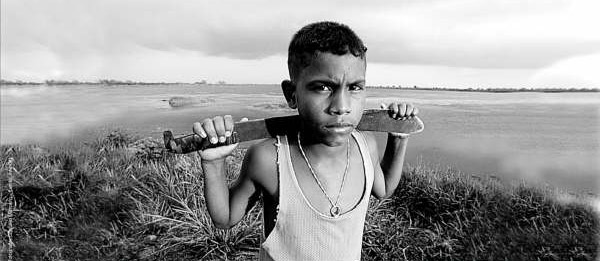
|  |  |  Editorials | Issues | November 2009 Editorials | Issues | November 2009  
Mexico's Dam Projects May Flood Villages
 Sergio Solache - USA Today Sergio Solache - USA Today
go to original
November 12, 2009


| | Drought conditions in larger areas force need for reservoirs, which can wipe out small communities. (InternationalRivers.org) |  |
Acasico, Mexico – A terrible future is foretold on the walls of the town church here.

From floor to ceiling, the sanctuary is covered in scenes of an apocalyptic flood. Water cascades out of a flaming heart in the sky. Buildings disappear under water. A cross floats by.

The murals are old and crumbling, and no one is sure who painted them.

"But it's like a sign," said villager Enedelia Quezada, 55. "Like somebody knew what was going to happen here."

Like other villages around Mexico, Acasico will soon be submerged under water, falling victim to dam projects aimed at meeting the water demands of factories, vegetable farms and the country's growing cities.

Since 2006, the government has flooded 11 villages to build two reservoirs. Four more dams, which would destroy four villages, are in the works.

A seventh dam project, La Parota, would wipe 36 communities off the map. In total, a few thousand people have lost or could lose their homes, said Esteban de Esesarte, an activist with the Mexican Movement for People Affected by Dams.

It's a striking contrast to the USA, where dam construction has slowed because of environmental concerns. Many U.S. dams are being torn down, said Serena McClain, associate director of river restoration at American Rivers, a conservationist group. Of the more than 700 torn down in the U.S. since 1912, 466 have been demolished since 1999, McClain said.

In Mexico, the dam projects have cast a pall over small towns already hit by the recession that spread from the United States.

In Acasico, 50 miles northeast of Guadalajara, many of the village's 127 residents blame the stress for the deaths of several seniors who died recently.

The government says Mexico desperately needs the water, and it has promised to relocate all of the villagers to new, modern subdivisions.

Some residents are refusing to budge. "I'm not moving," said Lauro Jáuregui, 88, of the colonial town of Temacapulín. "I guess I'll be taking my baths in the cold water of the reservoir."

Dry country

Mexico has long had a shortage of water. The country gets little rain from late October to May, and the western and eastern ranges of the Sierra Madre block storms from reaching the center of the country. Much of northern Mexico is desert.

The country depends on 52 major reservoirs, most of them built in the 1960s and 1980s.

From 1996 to 2006, Mexico did not build a single large dam.

Meanwhile, Mexico's population grew 13%, from 91.2 million to 103.3 million, and the 1994 North American Free Trade Agreement created a boom in factories and large-scale farms that export vegetables to the United States. Both consume large amounts of water.

The water situation is especially dire in Mexico City, where about one-fifth of all Mexicans live.

The capital is suffering its worst drought in 60 years, and overpumping of wells has caused the colonial center to sink 30 feet since the early 1900s, tilting and ripping apart historic buildings.

The government has no choice but to start building dams again, said Jose Ardavín, assistant director for potable water at the National Water Commission.

"It's the only way of ensuring viable water supplies for this country's future," he said.

Evangelina Peña, 46, says she watched from shore as the rising water behind the El Cajón dam slowly consumed her family's plum orchard. "We lived there, we worked there, we lived off that land," she said. "You feel terrible, watching it sink into the water."

Doomed towns

In another doomed village down the road from Acasico, a welcome sign written in white stones on a hillside says: "Since the Sixth Century, Temacapulín welcomes you."

The shady plaza, stone gazebo and 250-year-old Basilica of Our Lady of Remedies were all restored in recent years with money sent home by migrants. Metal plaques thank Temacapulín's "Absent Sons" in the USA.

The village lies on the Green River, upstream of the planned Zapotillo Dam. About 500 residents in Acasico, Temacapulín and the rural community of Palmarejo are scheduled to be relocated.

The dam will be 347 feet high and cost $190 million, the National Water Commission says.

The reservoir the dam creates will provide water for Guadalajara, Mexico's second-largest city, as well as factories and farms in the country's central plateau.

Residents have held protests in Guadalajara, Monterrey, Tijuana, Los Angeles and San Francisco in an attempt to stop the project. They've issued a CD with protest songs and starred in a documentary about the movement. A general store sells T-shirts saying "Let's save Temaca" – the town's nickname.

On a recent afternoon, volunteers met in a church to organize their latest project: documenting the entire town with photos for a traveling art exhibition.

In Temacapulín, the government has agreed to move the facade of the Basilica of our Lady of Remedies and mount it on a new building.

That's not the case back in Acasico, where the Flamacordis Church and its apocalyptic murals cannot be moved. The church's walls are made of thousands of tiny stones that are too difficult to transport, said Francisca Garcia, one of the church's caretakers.

Local legend says the village's priest organized residents into a human chain to transport the stones down from the surrounding hills. It was built in the late 1800s, but there is no cornerstone telling the exact year.

"There used to be some old people here who could tell you," Quezada said. "But they all died from sadness."

Solache and Hawley are Latin America correspondents for USA TODAY and The Arizona Republic. Contributing: Chris Hawley |

 |
|  |



